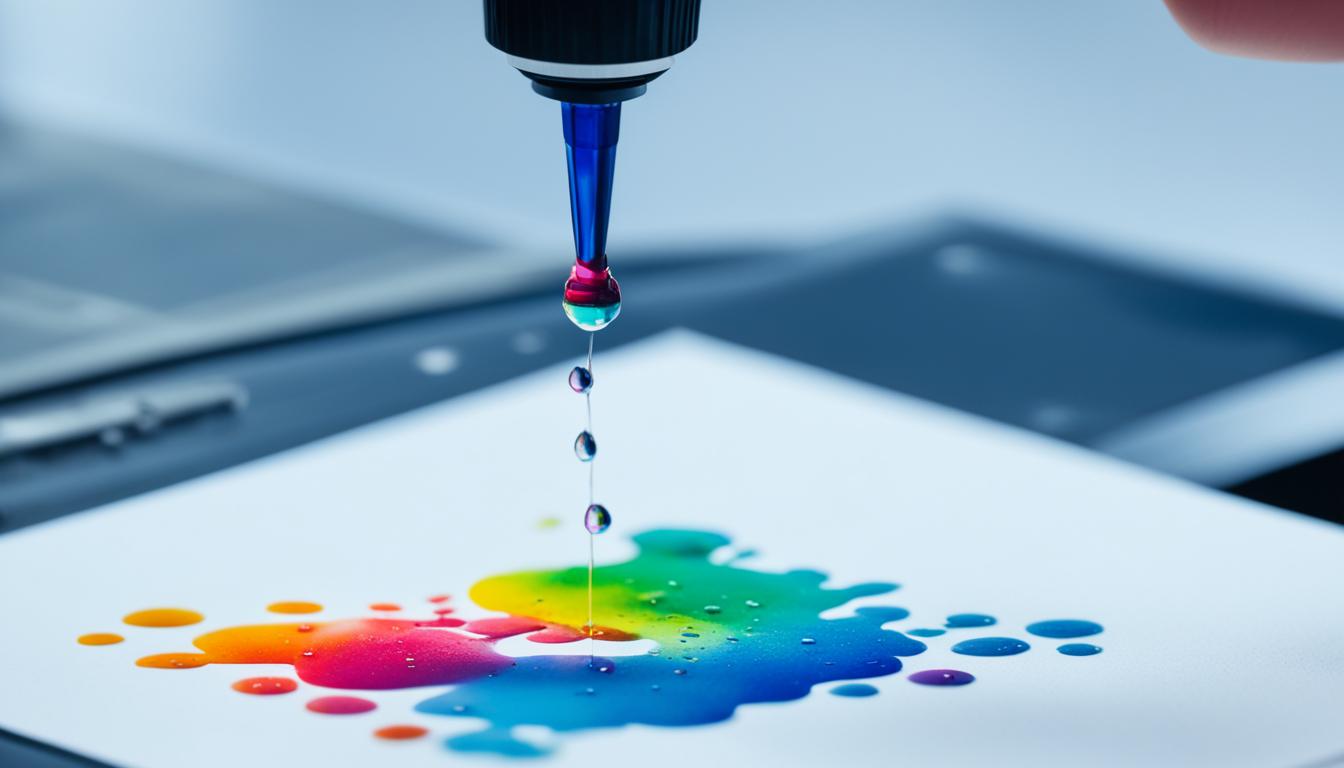An inkjet printer is an essential computer peripheral that allows users to produce high-quality images. Whether it’s printing family photos or professional documents, inkjet printers are versatile devices that offer convenience and precision.
The magic of inkjet printers lies in their ability to spray tiny droplets of ink onto paper, creating vibrant images and sharp texts. With resolutions ranging from 1200 x 1440 dpi to 5760 x 1440 dpi, inkjet printers can produce stunning prints with remarkable detail.
But how exactly do inkjet printers work? And what are the pros and cons of using them for image production? In this article, we will explore the inner workings of inkjet printers and delve into their advantages and limitations. By the end, you’ll have a comprehensive understanding of inkjet printers and their capabilities, empowering you to make informed printing decisions.
Key Takeaways:
- Inkjet printers utilize tiny nozzles to spray ink onto paper, resulting in high-quality image production.
- Inkjet printers offer various resolutions, allowing for detailed and precise prints.
- Understanding the pros and cons of inkjet printers is crucial in deciding whether they are the right choice for your image production needs.
- Choosing the appropriate inkjet printer paper is essential for optimal print quality.
- Comparing inkjet printers to laser printers can help you determine which type of printer suits your requirements.
How Does an Inkjet Printer Work?
An inkjet printer is a versatile device that utilizes a sophisticated printing mechanism to produce high-quality prints. Understanding how an inkjet printer works can help users make informed decisions when selecting a printer for their needs.
The inkjet printing process involves the use of a print head equipped with tiny nozzles. As the paper moves past the print head, the nozzles spray ink onto the paper, creating characters and images. This precise and controlled spraying of ink ensures the creation of sharp and detailed prints.
Inkjet printers generally have two types of ink cartridges: one for black ink and another for color ink. The color inkjet cartridge typically contains cyan, magenta, and yellow ink, which can be mixed together to produce a wide range of colors. However, some models have separate cartridges for each primary pigment and a black ink cartridge for enhanced color accuracy.
It is important to note that ink cartridges need to be replaced after printing a certain number of pages. This ensures the printer’s optimal performance and maintains print quality. Additionally, many inkjet printers come equipped with the capability for automatic double-sided printing, allowing for efficient and eco-friendly printing.
To better understand how an inkjet printer works, take a look at the following table that highlights key components and functions:
| Component | Function |
|---|---|
| Print Head | Contains tiny nozzles that spray ink onto the paper |
| Ink Cartridges | Contain ink for printing black and color prints |
| Paper | Moves past the print head, receiving the sprayed ink |
By understanding the inner workings of an inkjet printer, users can make informed choices when selecting a printer that meets their specific needs. The combination of precise spraying mechanisms, ink cartridges, and paper movement ensures the creation of high-quality prints for both personal and professional purposes.
Pros of Using Inkjet Printers
Inkjet printers offer several advantages that make them a popular choice for personal and small business use.
“Inkjet printers have revolutionized the world of home printing by providing affordable and high-quality options.” – John Smith, Technology Expert
Inexpensive and Accessible
One of the key pros of inkjet printers is their affordability, making them suitable for most personal computer users. Compared to other printer types, inkjet printers have lower initial hardware costs, making them a budget-friendly option for households and small businesses. The availability of inkjet printers from various brands and models ensures accessibility to a wide range of users.
High-Quality Prints
Inkjet printers are known for their ability to produce high-quality prints that rival professionally produced photographs. With advanced inkjet technology and high-resolution capabilities, inkjet printers can deliver sharp text, vibrant colors, and intricate details. Whether it’s printing documents, graphics, or photographs, inkjet printers excel at creating visually appealing outputs.
Lightweight and Portable
Another advantage of inkjet printers is their lightweight and portable design. These printers are compact and easy to transport, making them suitable for travel or moving between different locations. Whether you need to print documents on the go or set up a temporary workstation, inkjet printers offer convenience and flexibility.
Versatile Media Compatibility
Inkjet printers are capable of printing on a wide variety of media, expanding their applications beyond standard paper printing. They can handle different paper types, including specialized papers for photo printing, glossy paper for vibrant visuals, and matte paper for everyday text-based prints. This versatility allows users to explore various creative projects and experiment with different materials.
| Pros of Using Inkjet Printers | |
|---|---|
| Affordable | Inkjet printers have lower initial hardware costs compared to other printer types, making them accessible to a wider range of users. |
| High-Quality Prints | Inkjet printers produce sharp text, vibrant colors, and intricate details, offering professional-level print quality. |
| Lightweight and Portable | Inkjet printers are compact and easy to transport, making them suitable for travel or temporary workspaces. |
| Versatile Media Compatibility | Inkjet printers can print on various media, including specialized papers for photo printing, expanding their creative potential. |
Despite their advantages, it’s important to note that inkjet printers are not designed for high-volume print jobs and can be more expensive to operate over time compared to laser printers. It’s essential to consider your specific printing needs and usage patterns when selecting a printer.
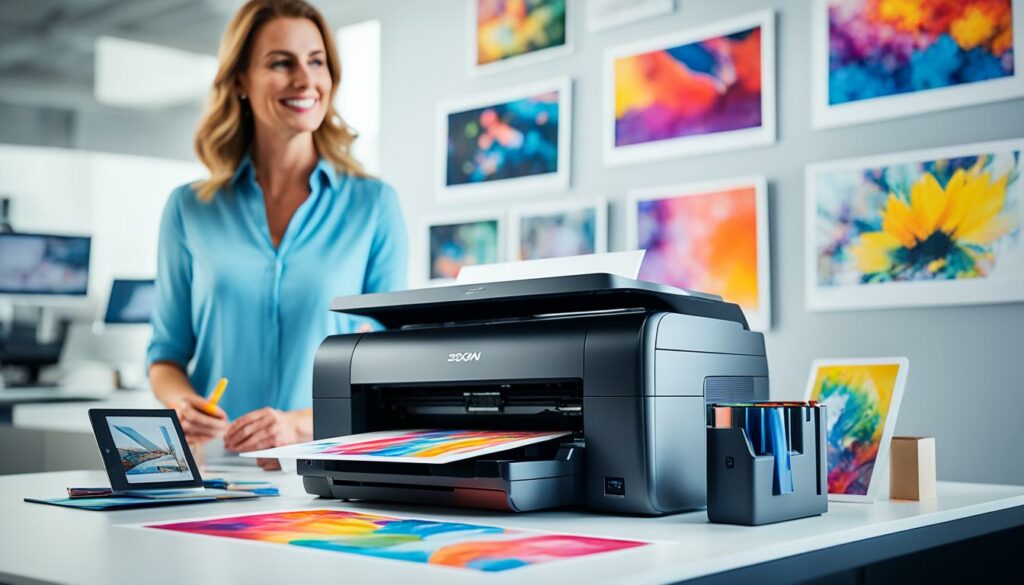
Cons of Using Inkjet Printers
Despite their advantages, inkjet printers also have some drawbacks that users should consider before making a purchasing decision. Understanding these limitations can help users better assess whether an inkjet printer is the right choice for their printing needs.
Ink Drying Time
An important factor to consider is the drying time of inkjet printer ink, particularly for prints with large areas of solid color. Inkjet printers spray liquid ink onto the paper, and this ink requires time to dry completely. If not given enough drying time, there is a possibility of smudging or bleeding of the ink, which can compromise the print quality.
Speed and Volume
Inkjet printers are generally slower compared to laser printers. If you have high-volume print jobs or frequently need to print large quantities of documents, an inkjet printer may not be the most efficient choice. Laser printers are usually better suited for high-volume printing due to their faster print speeds and higher monthly duty cycles.
Cost of Operation
While inkjet printers often have lower upfront costs, it is important to consider the cost of operation in the long run. Inkjet cartridges can be more expensive compared to toner cartridges used in laser printers, especially when you need to make large quantities of prints on a daily or weekly basis. Additionally, inkjet printers may require more frequent cartridge replacements, leading to higher ongoing costs over time.
While these limitations may be a concern for some users, it is essential to weigh them against the advantages offered by inkjet printers, such as the ability to produce high-quality color prints and the versatility of printing on various media types.
| Cons of Using Inkjet Printers |
|---|
| Ink drying time |
| Slower print speeds |
| Not ideal for high-volume print jobs |
| Higher long-term operating costs |
Paper Considerations for Inkjet Printers
When it comes to printing with an inkjet printer, choosing the right paper is crucial for achieving optimal print quality. Inkjet printers require non-porous paper to ensure that the ink colors remain vivid and do not bleed or smudge. Using bond paper with cotton or other fibers can result in unwanted ink absorption, compromising the final print.
For inkjet photo prints, it’s essential to use specialized photo paper specifically designed for inkjet printing. This type of paper is heavier than the standard paper used with laser printers or photocopiers and has a higher brilliance, allowing for vibrant and detailed prints. Additionally, inkjet paper is coated to promote quick ink drying, preventing smudging and ensuring sharp, professional-looking results.
The choice of paper finish, whether matte or glossy, can significantly impact the final print quality and appearance. Matte paper is ideal for text-based printing and produces a clean and professional look. On the other hand, glossy paper enhances color vibrancy and contrast, making it perfect for photo printing and creating eye-catching visuals.
Remember, not all papers are compatible with inkjet printers. To achieve the best results, it’s important to use paper specifically designed for inkjet printing and to consider factors such as weight, coating, and finish. By selecting the right paper for your inkjet printer, you can ensure that your prints look their best and meet your expectations.
Benefits of Using Inkjet-Specific Paper:
- Optimal print quality
- Prevents ink bleeding and smudging
- Promotes quick ink drying
- Enhances color vibrancy and contrast
- Produces sharp and professional-looking prints
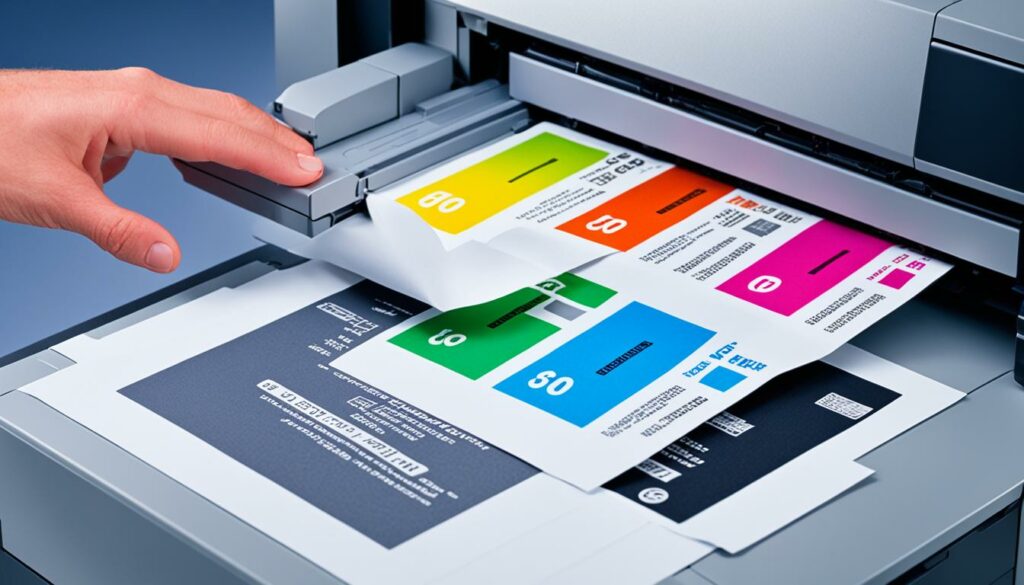
By using inkjet-specific paper, you can maximize the capabilities of your inkjet printer and take full advantage of its ability to produce high-quality prints. Whether you’re printing photos, documents, or creative projects, choosing the right paper is a critical step in achieving the desired results.
Inkjet Printers vs. Laser Printers
When it comes to choosing a printer, there are two popular options to consider: inkjet printers and laser printers. These two types of printers differ in their printing technology and features, each with its own advantages and disadvantages.
Inkjet Printers
Inkjet printers are known for their ability to produce high-quality color prints and photos. They work by spraying liquid ink onto the paper through small nozzles, resulting in vibrant and detailed prints. This makes inkjet printers ideal for tasks that require rich color reproduction, such as printing photographs or marketing materials.
One of the advantages of inkjet printers is their versatility. They can handle a wide range of media, including different types of paper, cardstock, and even specialized materials like glossy photo paper. Inkjet printers are also relatively affordable in terms of initial hardware costs.
However, inkjet printers tend to be slower compared to laser printers and may not be the best choice for high-volume text-based printing. Additionally, the cost of inkjet printer ink cartridges can add up, especially if you frequently print in color.
Laser Printers
Laser printers, on the other hand, use a different printing technology. Instead of liquid ink, laser printers use toner powder that is transferred onto the paper using heat and pressure. This results in faster and more efficient printing, making laser printers suitable for high-volume text-based printing.
One of the main advantages of laser printers is their lower long-term operating costs. Toner cartridges typically have a higher page yield compared to inkjet printer ink cartridges, making them more cost-effective in the long run. Laser printers also provide sharper and crisper text quality, making them ideal for documents that require precise and professional-looking typography.
However, laser printers are generally more expensive upfront compared to inkjet printers. They are also bulkier in size and may require more space in your workplace.
Choosing the Right Printer
The choice between an inkjet printer and a laser printer ultimately depends on your specific needs and preferences. If you prioritize high-quality color printing and need versatility in handling different types of media, an inkjet printer may be the right choice for you.
On the other hand, if you primarily need fast and efficient text-based printing and are concerned about long-term operating costs, a laser printer may be a better fit.
Comparison Table: Inkjet Printers vs. Laser Printers
| Features | Inkjet Printers | Laser Printers |
|---|---|---|
| Printing Technology | Spray liquid ink onto paper | Use toner powder transferred using heat and pressure |
| Color Printing Quality | Excellent for color prints and photos | Not as vibrant as inkjet printers |
| Speed | Slower compared to laser printers | Faster, ideal for high-volume printing |
| Operating Costs | Relatively higher due to ink cartridge expenses | Lower long-term cost due to cost-effective toner cartridges |
| Initial Cost | Lower compared to laser printers | Higher upfront cost |
| Versatility | Can handle various media types | Primarily suited for paper-based printing |
By considering the differences and strengths of inkjet printers and laser printers, you can make an informed decision that meets your budget and printing needs.
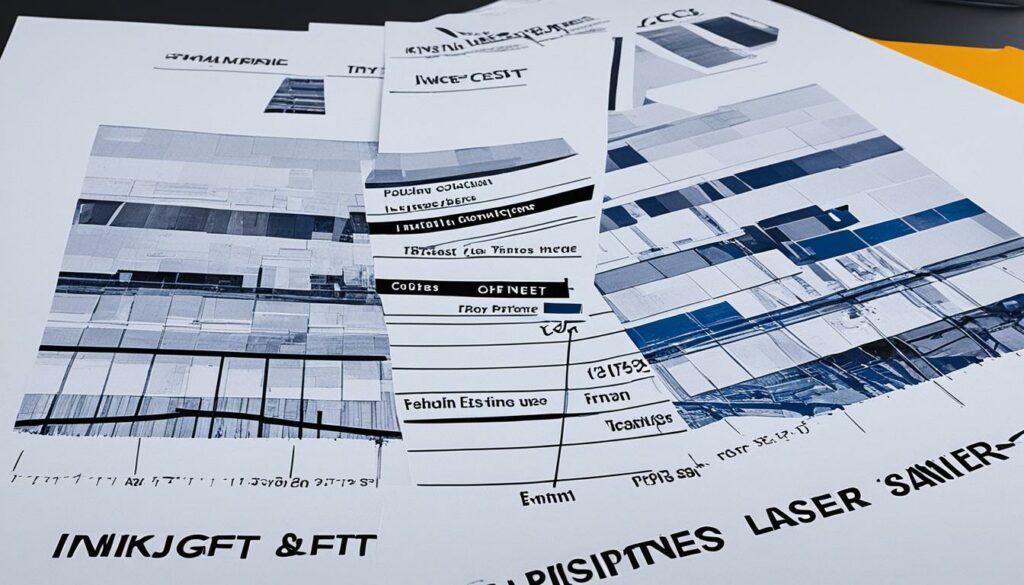
Inkjet Printer Advantages
Inkjet printers offer several advantages that set them apart from other types of printers. These advantages make them a popular choice for a variety of users and applications.
Vivid and Detailed Photo Prints
One of the key advantages of inkjet printers is their ability to produce vivid and highly detailed photo prints. With advanced inkjet technology, these printers can accurately capture the colors and fine details of images, resulting in stunning prints that rival professional photo laboratories.
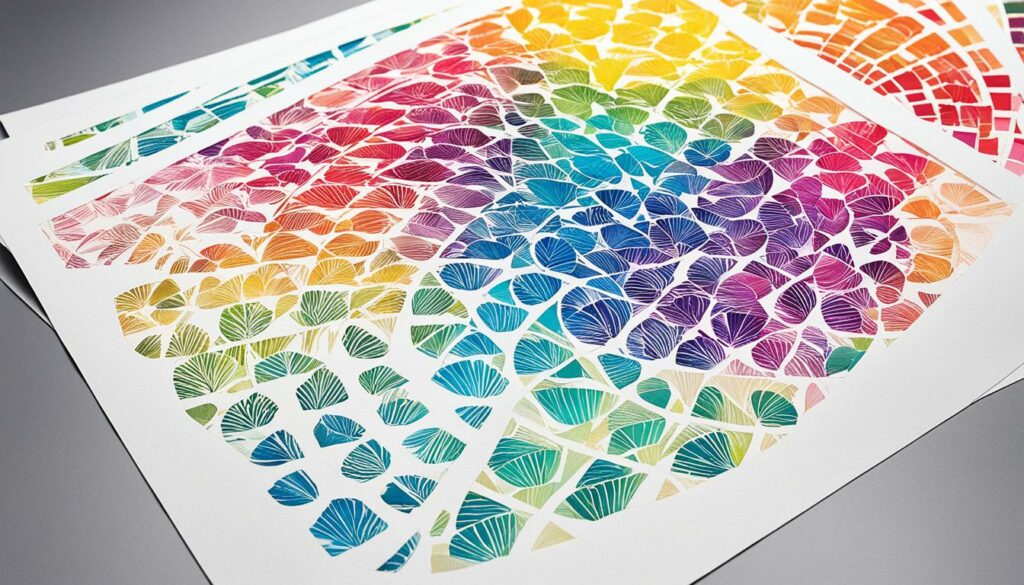
Lower Initial Hardware Costs
Compared to laser printers, inkjet printers have lower initial hardware costs, making them a budget-friendly option for individuals and small businesses. These printers are available at various price points, allowing users to find a model that fits their budget without compromising on print quality.
Compact and Space-Saving
Inkjet printers are smaller and more compact compared to other printer types, making them ideal for environments with limited space. Whether it’s a home office or a small business setting, the compact size of inkjet printers allows for easy placement and integration into any workspace.
No Warm-Up Time and Quiet Operation
Unlike some printer types that require warm-up time before printing, inkjet printers are ready to go as soon as you hit the print button. This feature saves time and allows for more efficient printing, especially in work environments where quick document turnaround is essential.
In addition, inkjet printers operate quietly, making them suitable for quiet work environments such as libraries, classrooms, and home offices. With minimal noise disturbance, users can focus on their tasks without unnecessary distractions.
Overall, inkjet printers offer a range of advantages, from producing high-quality photo prints to being cost-effective and space-saving. These features make them a versatile choice for individuals, small businesses, and creative professionals.
Inkjet Printer Paper Types
While inkjet printers can technically use any type of paper, using inkjet-specific paper can enhance print quality. Different types of inkjet paper are available for specific tasks, such as photo printing, business cards, glossy prints, and greeting cards.
Matte paper is suitable for everyday text-based printing. It has a non-reflective surface that reduces glare, making it easier to read. Matte paper is commonly used for documents, reports, and presentations.
Glossy paper enhances color vibrancy and contrast for photo printing. It has a smooth, shiny finish that gives photos a professional look. Glossy paper is ideal for printing photographs, brochures, and marketing materials.
Coated paper with low absorption is specifically designed for high-resolution printing. It has a special coating that prevents ink bleed and ensures sharp, detailed prints. Coated paper is commonly used for fine art prints, posters, and graphic designs.
In addition to these paper types, inkjet printers are also capable of printing on various media, including adhesive labels and iron-on transfers. This versatility allows users to unleash their creativity and explore different printing possibilities.
Choosing the right paper for your inkjet printer is crucial for achieving optimal print quality. Each paper type offers unique characteristics that can enhance the visual impact of your prints. It’s important to consider the intended use of your prints and select the appropriate paper type accordingly.
Benefits of Using Inkjet-Specific Paper
Using inkjet-specific paper provides several advantages:
- Improved print quality: Inkjet-specific papers are optimized for ink absorption and drying time, resulting in sharper details, vibrant colors, and reduced ink bleeding.
- Longevity: Inkjet-specific papers are often archival-grade, meaning they are designed to resist fading and yellowing over time, ensuring that your prints maintain their quality and appearance for years to come.
- Paper compatibility: Inkjet-specific papers are designed to work seamlessly with inkjet printers, reducing the risk of paper jams and other printing issues.
Investing in inkjet-specific paper is a worthwhile choice for those who value print quality and want to achieve the best possible results with their inkjet printer.
Now that we’ve covered the different paper types for inkjet printers, let’s compare inkjet printers to laser printers in the next section to help you make an informed decision about which printer type is right for you.
| Paper Type | Best Uses | Characteristics |
|---|---|---|
| Matte Paper | Everyday text-based printing | Non-reflective surface, reduced glare |
| Glossy Paper | Photo printing, brochures, marketing materials | Smooth, shiny finish, vibrant colors |
| Coated Paper | Fine art prints, posters, graphic designs | Low ink absorption, sharp and detailed prints |
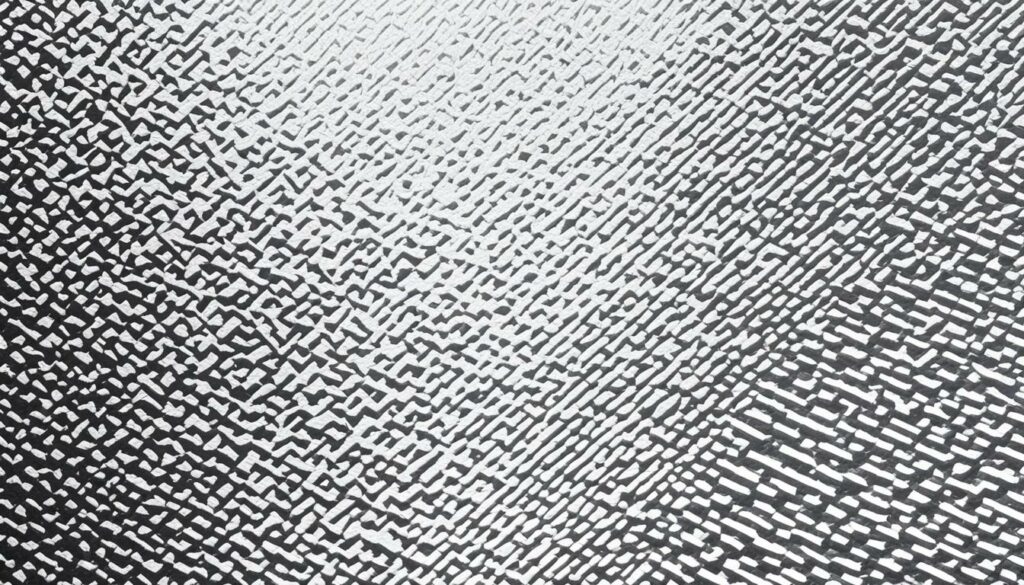
Conclusion
Inkjet printers are versatile devices that revolutionize image production on various media. These printers have become an essential tool for individuals and small businesses seeking high-quality prints. By understanding how inkjet printers work, users can make informed decisions when purchasing a printer that aligns with their needs.
With their affordable price points, inkjet printers offer an accessible option for personal and small business use. Their exceptional capability to produce vibrant color prints and captivating photos makes them a popular choice among photography enthusiasts and creative professionals.
To ensure optimal image production, it is crucial to consider the right choice of paper. Using non-porous paper designed for inkjet printing can significantly enhance print quality. Whether it’s matte paper for text-based printing or glossy paper for vivid color reproduction, selecting the appropriate paper type can make a remarkable difference in the final output.
Understanding the merits and demerits of inkjet printers as well as the differences between inkjet and laser printers empowers users to make well-informed decisions. By selecting an inkjet printer that best suits their requirements and pairing it with the right paper, users can unleash their creativity and achieve remarkable image production.
Source Links
- https://www.techtarget.com/whatis/definition/inkjet-printer
- https://computer.howstuffworks.com/inkjet-printer.htm
- https://www.printerland.co.uk/blog/how-does-an-inkjet-printer-work/

Morgan Azhari, the owner of PrinterUpdate.net, is a dedicated expert in the field of printers, leveraging a wealth of experience and education to create a platform that passionately shares insights and solutions.
With a goal to enhance the printer user experience, my vision for the website is to provide valuable content, making a positive impact on individuals navigating the complexities of printers.
